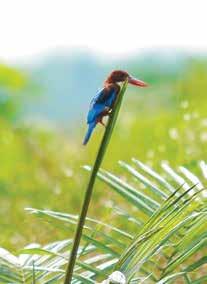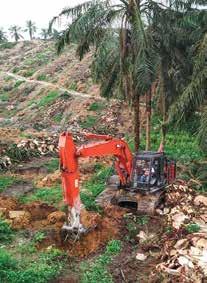
4 minute read
Biodiversity and Conservation
We believe in the importance of protecting Indonesia’s forests from irresponsible and unsustainable we adhere strictly to our Sustainability Policy which sets out our commitments to biodiversity and conservation. In particular, this includes: • No Deforestation: Protecting areas of high conservation value (HCV) and high carbon stock (HCS), • No Peat: Protecting peatland regardless of depth These standards also apply to our smallholders, and we are committed to investing our best efforts and including compliance with our NDPE commitments.
Moratorium on New Developments
We have in place a moratorium on any forest clearance and new peatland development. Since 2003, we have not opened up new areas for plantation and we focus instead on replanting and increasing yield in our existing estates. All of our current estates, including those owned by our plasma smallholders, were developed in the 1990s on degraded forests with low biodiversity value. Approximately every 25 years, we conduct replanting of new trees when our existing oil palms have reached maturity and are no longer considered productive in terms of yield and quality of FFB. In line fronds are allowed to decompose to form fertiliser for new plants. This process of preparing the land for replanting usually takes about six months. We use high quality seeds developed in-house for replanting, and also support our plasma and independent smallholders in this process. For further information on our quality seeds, refer to page 23. For further information on how we support smallholders, refer to pages 20-25
Identifying and Protecting Conservation Areas
304-4
In line with our Sustainability Policy, we conduct relevant assessments and develop and implement conservation and management plans prior to any plantings. This includes HCV assessments, peatland mapping and Social and Environmental Impact Assessments. All of our existing estates have been subjected to HCV assessments conducted by third-party RSPO These assessments include issues such as habitat quality, soil conditions, peat presence and river quality. Critically Endangered and Endangered in the IUCN Red List, including the Northern River Terrapin, Scaly Anteater, Dark-handed Gibbon and Sumatran Elephant. A full list of endangered species found in our concessions can be found on our website.
To ensure the long-term protection of these conservation areas, we have in place a system which integrates the recommendations of HCV, HCS, Social and Environmental Impact Assessments (SEIAs) and peatland assessments within our larger landscape planning.

2003
we have not opened up new areas for plantation since 2003

In order to ensure that these management plans are implemented, we have established a dedicated team to oversee the process:
Position Responsibilities
Head of Environment and Sustainability Formulation and implementation of strategic plan Regular reporting on performance to management (twice a year)
Concervation Coordinator (North Sumatra, Riau & Jambi) Ensures all strategic plans related to management of conservation areas are well executed Coordinate with assistants in own region
Coordinator’s Assistant Execute strategic plans to protect HCV areas in their region
Estate Foreman wildlife monitoring
species on a daily basis. We have a team on the ground patrolling our concession areas, and if a breach in our policy is discovered, individuals will be given a warning or for a major violation, prosecuted by law.
Peat Management
307-1
We recognise the importance of peatland ecosystems as crucial carbon sinks for the planet and are regardless of the depth of peat. Prior to any new planting, peat experts from our R&D department conducts peatland mapping and assessments. As part of the assessments, they produce a peatland map showing areas that should be protected from any new development. For peat areas assessed to be unsuitable for replanting, we collaborate with expert stakeholders and communities to explore options for long-term restoration or alternative uses. Some of our plantations in North Sumatra and Riau are in peatland areas. We are currently managing 7 1 .
Peatland Area (Ha)
North Sumatra
Riau
Total Peatland Area (Ha)
23,055
4,354
27,409
Note: There are no peatland areas in Jambi. To preserve peatlands, we implement the following measures in line with the RSPO Best Management Practices on Peatland:
• Measuring drainage levels: peatland areas in order to determine the suitability of the land. This helps us to determine the best water management approach for the peatland, for example through the use of bunds, water gates procedure requires that water levels should be maintained throughout the year at between 50 to 70cm from ground level. To do this, we create water barriers or gates on each drainage channel. • Measure subsidence levels: In addition, we preserve peatland by installing subsidence poles at strategic locations to monitor the level of peat subsidence on a monthly basis.
Environmental Compliance In 2019 and 2020, we had 2 cases of non-compliance with environmental laws and regulations. The thrown by local anglers. The second incident was regarding POME disposal rivers causing disruption to the ecosystem, though it was later found to be within acceptable parameters and thresholds. All environmental-related grievances can be found in the Grievance Update section of our website.






